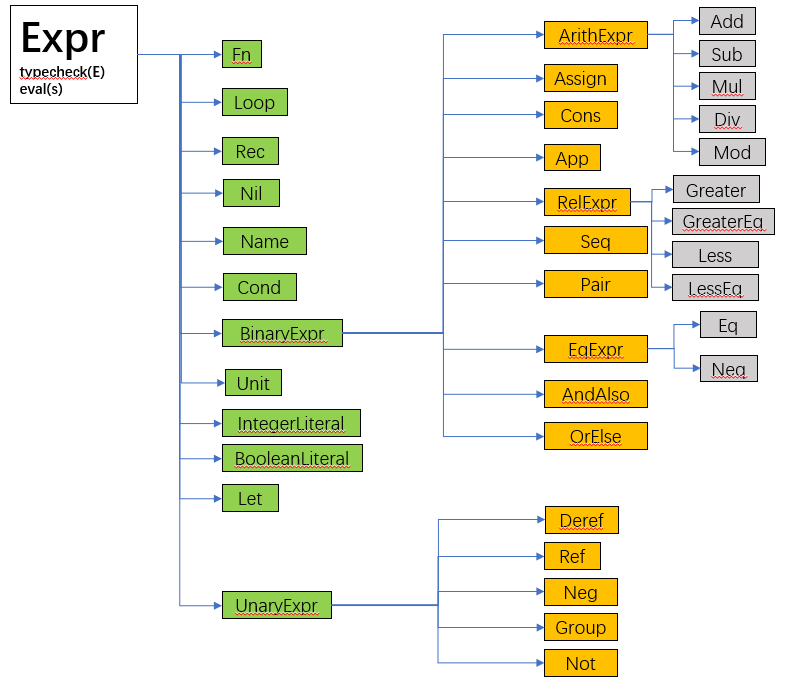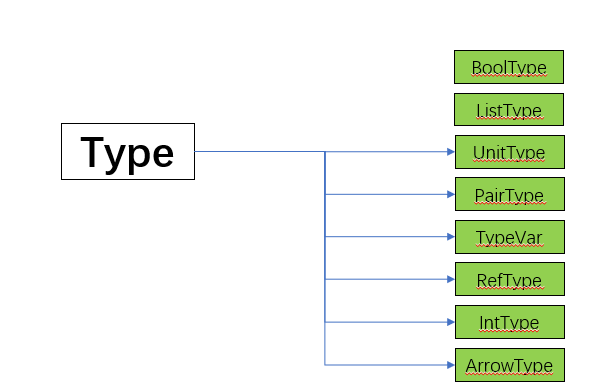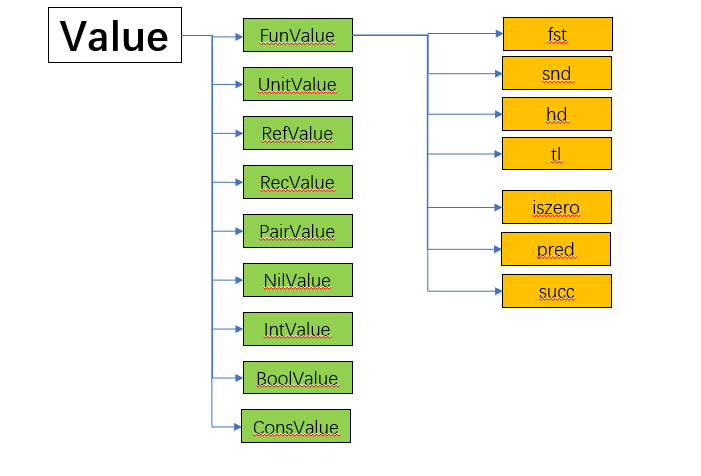Ziteng Yang
This is the implementation document of an interpreter for the programming language SimPL (pronounced simple), which is a simplified dialect of ML and can be used for both functional and imperative programming.
See project.pdf for the specification of this language and the original goals.
The project has been uploaded to https://github.com/Youngzt998/SimPL-Interpreter
The entry of the main Java class was in src/simpl/interpreter/Interpreter.java. Besides, other code files are listed:
-
src/simpl/parser/: the parser generator and parser used in this project for SimPL./ast/*.java: Classes representing the abstract syntax tree for SimPL
-
src/simpl/interpreter/-
./*Value.java: The value class and all its subclass, used for evaluation steps -
./liband../pcf: Several predefined functions -
State.java,Env.java, ... : Classes representing the environment of a SimPL program evaluation
-
-
src/simpl/typing/*.java: Classes representing the types of SimPL
Readme.md: this fileproject.pdf: a specification of SimPL, i.e. the original goal of this projectstructure.pptx: a graphic structure showing the sub-tying relations among all Java classes
A packaged .jar file was uploaded to the examples file, i.e. ./examples/SimPL.jar. There are also some SimPL program. See factorial.spl as an example:
let fact = rec f => fn x => if x=1 then 1 else x * (f (x-1))
in fact 4
end
(* ==> 24 *)
To test the interpreter, open the terminal in this file and run the following code in command line (Java environment was required):
java -jar ./SimPL.jar ./factorial.splIf every thing goes right, we will get the output:
int
24
Any valid program of SimPL would be parsed into a Java abstract class Expr [defined in src/simpl/parser/ast/Expr.java], which has several subtype, defined as follows:
public abstract class Expr {
public abstract Expr replace(Symbol x, Expr e);
public abstract TypeResult typecheck(TypeEnv E) throws TypeError;
public abstract Value eval(State s) throws RuntimeError;
}Three member function are declared:
replace: Replace a variablexinthisexpression with another expressetypecheck: Check the type ofthisexpression and throwTypeErrorif it has type error.eval: Evaluate the expression following the operational semantics in the Specification
A Symbol x can be considered as a variable expression, but it should be encapsulated in Name(x) as an expression.
The next figure suggest the sub-typing structures of all expressions:
We use Add (arithmetic) and Not (boolean) expression as examples.
Addexpression was inherited fromArithExprexpression that implements several common features of arithmetic expressions. AgainArithExprwas inherited from binary expressionBinaryExpr.
In Java, it can be implemented as the following (eval method was left in evaluation part):
public abstract class BinaryExpr extends Expr {
public Expr l, r;
public BinaryExpr(Expr l, Expr r) {
this.l = l;
this.r = r;
}
}which states that a binary expression consists of two expressions, and
public abstract class ArithExpr extends BinaryExpr {
public ArithExpr(Expr l, Expr r) {
super(l, r);
}
@Override
public TypeResult typecheck(TypeEnv E) throws TypeError {
...
}
}that defines the same typing rule of all arithmetic expressions, and
public class Add extends ArithExpr {
public Add(Expr l, Expr r) {
super(l, r);
}
public String toString() {
return "(" + l + " + " + r + ")";
}
@Override
public Add replace(Symbol x, Expr e) {
return new Add(l.replace(x, e), r.replace(x, e));
}
@Override
public Value eval(State s) throws RuntimeError {
...
}
}that defines the specific evaluation rules of Add.
The replace method was defined recursively.
-
Notexpression is similar toAdd, but it was inherited fromUnaryExpr:public class Not extends UnaryExpr { public Not(Expr e) { super(e); } public String toString() { return "(not " + e + ")"; } public Not replace(Symbol x, Expr e) { return new Not(this.e.replace(x, e)); } @Override public TypeResult typecheck(TypeEnv E) throws TypeError { ... } @Override public Value eval(State s) throws RuntimeError { ... } }
-
The Lambda calculus in SimPL was denoted by
fn x => eIn Java implementation, it consist of a
Symbol xand anExpr e:public class Fn extends Expr { public Symbol x; public Expr e; /* specific method for Fn */ ... }
Note that the
replaceinterface should comparethis.xwithx:@Override public Fn replace(Symbol x, Expr e) { if(this.x.toString().equals(x.toString())){ return this; } else return new Fn(this.x, this.e.replace(x, e)); }
-
The functional application
$e_1\ e_2$ was just a binary expression.
The Let expression Symbol member representing the variable x
public class Let extends Expr {
public Symbol x;
public Expr e1, e2;
/* specific method for Let */
...
}The SimPL language also has some structures such as list and pair. The list was named Cons and the pair was Pair. The Java class of them are similar to the previous ones.
SimPL also has imperative features such as while-loop, assignment and (virtual) memory location.
-
Loopwas the while-loop$while\ e_1\ do\ e_2$ of SimPL. -
Refrepresents a unary operation$ref\ e$ denoting a memory reference to$e$ ; correspondingly,Derefrepresents a unary operation$!e$ that aim to get the value from the memory reference. -
Assignrepresent an assignment$e_1\ :=\ e_2$ that change the value of the memory referred by$e_1$
All the Java classes' structure of the above expressions are similar to the previous ones, varying in their members as well as the replace, typecheck and eval method.
[ Note: Although for the interpreter, type checking runs first, it might give a better understanding about the code to see evaluation step first. ]
Before running the program, we should do a type checking first to avoid some runtime error.
An abstract class Type was defined representing the data type of SimPL:
public abstract class Type {
public abstract boolean isEqualityType();
public abstract Type replace(TypeVar a, Type t);
public abstract boolean contains(TypeVar tv);
public abstract Substitution unify(Type t) throws TypeError;
public static final Type INT = new IntType();
public static final Type BOOL = new BoolType();
public static final Type UNIT = new UnitType();
}-
isEqualityTypedecide whetherthistype was comparable (such as$e_1 = e_2$ ) -
replacechange all occurrence of a type variableainthistype tosome typet` -
containschecks whetherthistype contains the type variabletv -
unifygives aSubstitutinostructure stating thatthistype is equal to the typet, which would be used in the unification process
The following figure shows the sub-type relation of Type
The Substitucion was a data structure that implements the unification algorithm in type inference.
It has a method apply, that transform one type to another type, i.e.
public abstract class Substitution {
public abstract Type apply(Type t);
/* Some methods and subtypes */
...
}It has three subtype
-
Identity: the identity function, which means "do nothing": give thet, return thetprivate static final class Identity extends Substitution { public Type apply(Type t) { return t; } public String toString(){ return "Id"; } }
-
Replace: the single substitution$[a=t]$ private static final class Replace extends Substitution { private TypeVar a; private Type t; public Type apply(Type b) { return b.replace(a, t); } public String toString(){ return a + " = " + t; } }
-
Compose: the composition of two substitution$T * S(a)= T(S(a)) $ private static final class Compose extends Substitution { private Substitution f, g; ... public Type apply(Type t) { /** * The sequence is principle */ return g.apply(f.apply(t)); } ... }
The SimPL uses implicit type, and also has polymorphic types. Type inference was achieved, including Let-Polymorphism. Following cases of type checking for normal expressions and let expressions was used to suggest how to implement type inference by unification.
The interface typecheck generates the implementation:
Expr l, r;
...
@Override
public TypeResult typecheck(TypeEnv E) throws TypeError {
...
}Now we have expression l and r,, and current type environment E. We want to check whether l + r was a valid expression. The first thing is to check l under E:
TypeResult tr1 = l.typecheck(E);A TypeResult consists of a Substitution s and a Type t. An principle issue is that, this might give new type environment, so we must check r in the new environment:
TypeEnv NewE = tr1.s.compose(E);
TypeResult tr2 = r.typecheck(NewE);Now we have two result and two substitution. According to the constraint typing rule
/*
* Compose two substitution to get a new substitution
* then compose two substitution that {tr1.t = Int} and {tr2.t = Int}
*
* G |- e1: t1, q1 G |- e2:t2, q2 bop \in {+, -, *, /}
* ------------------------------------------------------------
* G |- e1 bop e2: int, q1 U q2 U {t1 = int} U {t2 = int}
*/we should give a new substitution composed by
- the ones from
l,rand - the hint
landr's type should beINT
Substitution comp = tr1.s.compose(tr2.s);
Substitution s1 = comp.apply(tr1.t).unify(Type.INT);
comp = comp.compose(s1);
Substitution s2 = comp.apply(tr2.t).unify(Type.INT);
comp = comp.compose(s2);
return TypeResult.of(comp, Type.INT);A crucial issue here is that comp.apply(tr1.t) would transform the last type result tr1.t to a more specific type
For the function TypeVar variable to join the type inference.
TypeVar a = new TypeVar(true);But we can still check the type of
TypeResult tr = e.typecheck(TypeEnv.of(E, x, a));We should know the type of this expression is some ArrowType, so we return a new ArrowType with the substitution, yet we might not get the full information of
ArrowType arrow = new ArrowType(tr.s.apply(a), tr.s.apply(tr.t));
return TypeResult.of(tr.s, arrow);Name is an expression corresponding to the single variable expression. To check the type of a variable, we could do nothing more but refer to current type environment. If current variable was not bound to any type, then we found a type error.
@Override
public TypeResult typecheck(TypeEnv E) throws TypeError {
// TODO
if (E.get(x) == null)
throw new TypeError("type error: symbol " + x + "not found");
return TypeResult.of(E.get(x));
}Most of the implementation are similar to the ones above by following the constraint typing rules, except Let since we wish to realize Let-Polymorphism by rule
/**
* Rule CT-LETPOLY:
* G |- e2[e1/x]: t2, q G|- e1: t1
* ---------------------------------
* G |- let x = e1 in e2 end: t2, q
*/which suggests us to replace x with e1 in e2 first and then do type checking instead of check e1 directly.
We still should run the typecheck
e1.typecheck(E);
because we do not wish
Then we can do the replacement and give the result:
TypeResult tr = e2.replace(x, e1).typecheck(E);
return TypeResult.of(tr.s, tr.s.apply(tr.t));After type checking, the program should run normally and it's time to evaluate the it.
We use the class Value to represent the final value
public abstract class Value {
public static final Value NIL = new NilValue();
public static final Value UNIT = new UnitValue();
public abstract boolean equals(Object other);
}The member of Value was very simple with a method equals to check the equality.
The following figure shows the sub-type relation of Value
The implementation of evaluation was shown by the following representative examples.
Again the Add was used as an example, now we implement the eval interface in Add to realize this evaluation step under
@Override
public Value eval(State s) throws RuntimeError {
// TODO
/*
Check Type ?
Or type already checked here?
*/
return new IntValue(((IntValue)l.eval(s)).n + ((IntValue)r.eval(s)).n);
}The evaluation was taken recursively (using Big-step Semantics) : just evaluate the left and the right, then add them together.
In Lambda Calculus, the function FunValue for the evaluation of Fn
public Symbol x;
public Expr e;
...
public Value eval(State s) throws RuntimeError {
// TODO
/**
* Just evaluate to a FunValue
*/
return new FunValue(s.E, x, e);
}Then we can implement the application App .
Firstly we know l must evaluate to a FunValue since it past the type check, then we evaluate r to a Value v2. Now the expression in the FunValue should replace its x with Value v2
public Expr l, r;
@Override
public Value eval(State s) throws RuntimeError {
FunValue v1 = (FunValue) l.eval(s);
Value v2 = r.eval(s);
return v1.e.eval(State.of(new Env(v1.E, v1.x, v2), s.M, s.p));
}The Let expression's evaluation step was very simple: evaluate the e1 to v1, then replace x in e2 by v1, while we do not replace it directly but update current environment instead to save computation and avoid renaming issues.
Value v1 = e1.eval(s);
return e2.eval(State.of(new Env(s.E, x, v1), s.M, s.p));If a Ref expression was evaluate, then a new memory unit was created, so the memory pointer should increase. After evaluation, the value of this expression should be stored in memory.
public Expr e;
...
@Override
public Value eval(State s) throws RuntimeError {
int i = s.p.get();
s.p.set(i + 1);
Value v = e.eval(s);
s.M.put(i + 1, v);
return new RefValue(i + 1);
}And if we want to get the memory content by Deref, we just get the memory pointer of v evaluated from e and search the (virtual) memory unit.
public Expr e;
...
@Override
public Value eval(State s) throws RuntimeError {
// TODO
/**
* e -> v where v = (ref vp)
* !e -> M(vp) where s = (E, M, p)
*/
RefValue v = (RefValue) e.eval(s);
return s.M.get(v.p);
}See fst as an example: it was a FunValue, and has a symble fst , and a special expression that return the first element of a variable named fst in current environment.
public class fst extends FunValue {
public fst() {
super(Env.empty, Symbol.symbol("fst"), getExpr());
}
private static Expr getExpr(){
Expr e = new Expr() {
@Override
public Expr replace(Symbol x, Expr e) {
return this;
}
@Override
public TypeResult typecheck(TypeEnv E) throws TypeError {
return TypeResult.of(new TypeVar(true));
}
@Override
public Value eval(State s) throws RuntimeError {
PairValue v =(PairValue) s.E.get(Symbol.symbol("fst"));
return v.v1;
}
};
return e;
}
}

